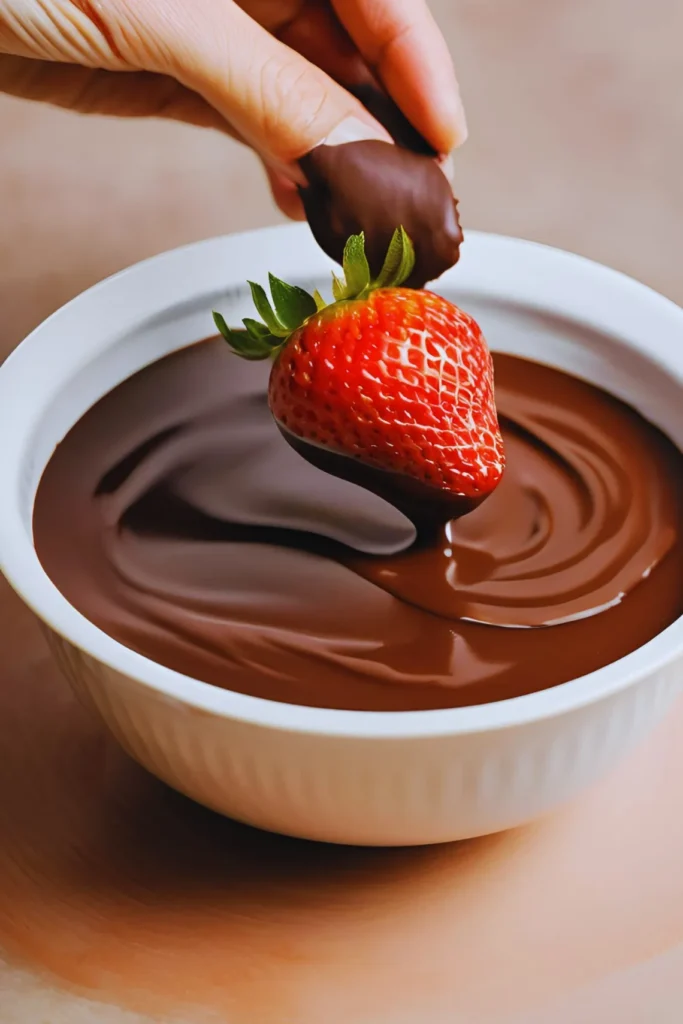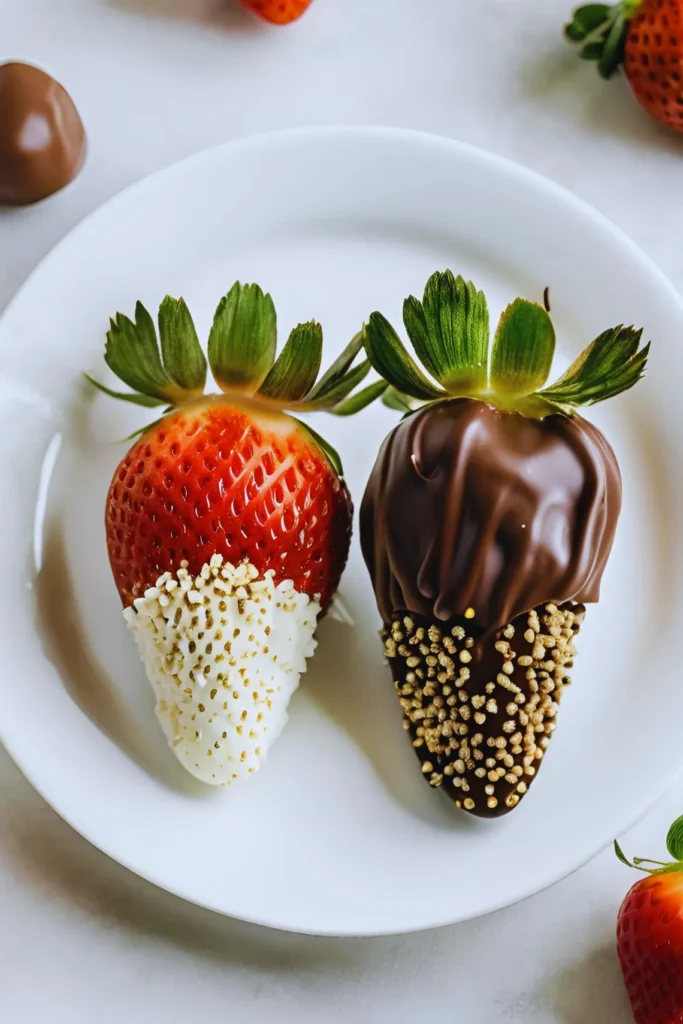How long do chocolate-covered strawberries stay fresh? This question often arises for those who enjoy this decadent treat. With their sweet, juicy center and smooth chocolate shell, chocolate-covered strawberries are a favorite for gifting and celebrations. However, their shelf life and freshness can be tricky to manage. From understanding their components to exploring the best storage practices, this article will guide you through the intricacies of keeping them fresh and delicious.

For more tips on enhancing your chocolate-dipping techniques, check out our guide on How to Get Chocolate to Stick to Strawberries.
Understanding Chocolate-Covered Strawberries
1. What Are Chocolate-Covered Strawberries?
Chocolate-covered strawberries are a luxurious dessert combining fresh strawberries dipped in melted chocolate. These treats are:
- Popular for special occasions, such as Valentine’s Day, weddings, and birthdays.
- Known for their balance of sweet, tangy, and rich flavors.
- A frequent choice for gifting, thanks to their elegant appearance.
The mix of perishable (strawberries) and non-perishable (chocolate) components makes maintaining their freshness crucial.
2. Factors That Determine How Long Chocolate-Covered Strawberries Stay Fresh
The freshness of chocolate-covered strawberries depends on several variables:
- Ingredients:
- Strawberries must be ripe but firm; overripe strawberries spoil quickly.
- High-quality chocolate, free of unnecessary additives, helps extend shelf life.
- Preparation:
- Thoroughly washing and drying strawberries is essential to prevent moisture buildup.
- Proper sealing techniques, like using airtight containers, play a significant role.
- Storage Conditions:
- Temperature and humidity directly impact how long the strawberries stay fresh.
The type of chocolate used is crucial for freshness. Learn more about different chocolate options in our detailed article on Chocolate-Covered Strawberries.
3. Ideal Conditions for Freshness
To maximize the shelf life of chocolate-covered strawberries, maintain:
- Cool temperatures: A consistent range of 35–45°F is ideal.
- Low humidity: Excess moisture can encourage mold growth.
- Ventilation: Avoid trapping air or moisture, which accelerates decay.
4. Shelf Life of Chocolate-Covered Strawberries
The average shelf life of chocolate-covered strawberries is relatively short:
- At room temperature: 12–24 hours.
- Refrigerated: 2–3 days if stored properly.
- Frozen: Up to 3 months, though freezing can alter texture and appearance.
As strawberries age, they lose moisture, which impacts both the fruit and the chocolate coating. Signs of spoilage include discoloration, a mushy texture, and a sour smell.
5. Why Do Strawberries Go Bad?
Strawberries are highly perishable due to:
- Their high water content, which promotes bacterial growth.
- Vulnerability to mold and bruising.
- The chocolate coating providing some protection but not preventing internal decay.
6. Role of Chocolate Coating
The chocolate coating acts as a protective barrier against air and moisture, slowing down spoilage. However:
- It doesn’t completely prevent decay as moisture from the strawberry can still seep out.
- Dark chocolate, due to lower sugar content, often extends freshness longer than milk or white chocolate.
Understanding the right way to coat your strawberries can help extend their freshness. Explore additional insights in The Best Frosting Options for Chocolate Cake.
7. Signs of Spoilage
Knowing when your strawberries have gone bad is key. Look for:
- Visual cues: Mold, discoloration, or cracking in the chocolate.
- Texture changes: Mushy strawberries or a sticky coating.
- Smell and taste: A sour or off-putting aroma indicates spoilage.
8. Store-Bought vs. Homemade
When it comes to freshness, store-bought and homemade options differ:
- Store-bought: Often contain preservatives, which can extend shelf life.
- Homemade: Free from preservatives but rely heavily on preparation and storage methods.
9. Common Mistakes That Shorten Freshness
Avoid these pitfalls to maximize shelf life:
- Using overripe or bruised strawberries.
- Not drying strawberries thoroughly after washing.
- Storing in containers that trap excess air or moisture.
- Exposing them to fluctuating temperatures.
10. The Role of Chocolate in Keeping Strawberries Fresh Longer
Premium ingredients can make all the difference:
- Chocolate: High-quality chocolate with natural cocoa butter resists melting and cracking.
- Strawberries: Fresh, firm strawberries without bruises last longer and taste better.
Storing Chocolate-Covered Strawberries to Keep Them Fresh
Proper storage is key to ensuring your chocolate-covered strawberries remain fresh and delicious. Whether you plan to keep them for a day or several weeks, the right techniques can significantly extend their shelf life while maintaining their appearance and taste.
1. The Best Temperature to Store Them
Temperature plays a critical role in preserving chocolate-covered strawberries:
- Refrigerator vs. Room Temperature:
- For short-term storage (under 24 hours), room temperature can work if conditions are cool and dry.
- For longer storage, refrigeration is essential, as it slows the growth of bacteria and mold.
- Consistency is Key:
- Fluctuations in temperature can cause condensation, leading to soggy strawberries and sticky chocolate.
The optimal storage temperature is between 35°F and 45°F, ensuring freshness without freezing.
2. How to Prepare for Storage
Preparation before storage is crucial to avoid common issues like moisture buildup or smudging:
- Cool Them Properly:
- Allow the chocolate to set completely before placing the strawberries in a container. Warm or soft chocolate can stick to surfaces.
- Airtight Containers:
- Use containers with tight seals to protect against air exposure.
- Avoid overcrowding, as the strawberries need space to prevent sticking.

3. Short-Term Storage Tips
If you only need to keep your strawberries fresh for a day or two:
- Arrange them in a single layer inside an airtight container.
- Use parchment paper or wax paper between layers if stacking is unavoidable.
- Keep the container in the refrigerator to maintain cool temperatures.
When ready to serve, let the strawberries sit at room temperature for about 30 minutes to restore their best flavor and texture.
4. Long-Term Storage Possibilities
While not ideal, freezing chocolate-covered strawberries can be a solution for longer storage:
- Freezing Process:
- Place the strawberries on a parchment-lined baking sheet and freeze until solid.
- Once frozen, transfer them to a freezer-safe airtight container or vacuum-sealed bag.
- Pros:
- Extends shelf life up to 3 months.
- Retains most of the flavor.
- Cons:
- Alters texture; the strawberries may become mushy after thawing.
- Chocolate may crack or develop a white bloom due to temperature changes.
To thaw, remove them from the freezer and let them sit in the refrigerator for several hours before serving.
5. Avoiding Moisture Buildup
Moisture is the enemy of both chocolate and strawberries:
- Why It Happens:
- Condensation forms when warm air contacts cold surfaces, such as refrigerated strawberries taken out into room temperature.
- Prevention Tips:
- Store the strawberries in a container with a layer of paper towels to absorb moisture.
- Avoid opening and closing the container frequently to minimize temperature shifts.
6. Using Paper Towels or Parchment Paper
Paper towels and parchment paper are inexpensive yet effective tools for maintaining freshness:
- Prevent Soggy Bottoms:
- Place a layer of paper towels at the bottom of the container to wick away excess moisture.
- Protect Chocolate:
- Use parchment paper to separate layers of strawberries, preventing them from sticking together or smudging.
7. How Packaging Impacts Freshness
The type of packaging can significantly affect how long chocolate-covered strawberries stay fresh:
- Best Options:
- Airtight glass or plastic containers.
- Resealable silicone bags for eco-friendly storage.
- Avoid:
- Aluminum foil or plastic wrap, which can trap moisture and lead to condensation.
Ensure the container is clean and dry before use to avoid introducing bacteria.
8. Transporting Chocolate-Covered Strawberries
If you need to transport your strawberries, extra care is needed to maintain their integrity:
- Tips for Safe Transport:
- Use a sturdy container with dividers or cushioning to prevent movement.
- Keep the container cool with ice packs, especially during hot weather.
- Avoid Heat and Agitation:
- Direct sunlight or excessive jostling can melt the chocolate or bruise the strawberries.
9. Refrigeration vs. Leaving Them Out
Deciding whether to refrigerate or leave your strawberries out depends on the time frame:
- Refrigeration:
- Necessary for storage longer than 24 hours.
- Helps preserve the chocolate’s texture and prevents bacterial growth in the strawberries.
- Room Temperature:
- Suitable for same-day consumption if stored in a cool, dry place away from direct sunlight.
For best results, always refrigerate any leftovers promptly.
10. Storing in Layers to Avoid Smudging
Presentation matters, especially for gifting or events. Proper layering techniques ensure your chocolate-covered strawberries look as good as they taste:
- Use parchment paper or wax paper to separate layers in the container.
- Avoid pressing down on the strawberries when stacking to prevent crushing or smearing the chocolate.
By following these steps, you can maintain their elegant appearance and ensure they stay fresh for longer.

Frequently Asked Questions
1. How long do chocolate-covered strawberries stay fresh at room temperature?
Chocolate-covered strawberries can remain fresh at room temperature for about 12 to 24 hours, but only under ideal conditions. If the environment is cool and dry, they can last closer to 24 hours. However, exposure to warm or humid conditions significantly shortens their freshness, as the strawberries may begin to release moisture, and the chocolate can sweat or melt. For best results, consume them the same day they’re made. Storing them in the refrigerator can help extend their shelf life if you’re not serving them immediately.
2. Can you refrigerate chocolate-covered strawberries immediately after dipping?
It’s not recommended to refrigerate chocolate-covered strawberries immediately after dipping them. When the chocolate hasn’t fully set, refrigerating too soon can cause condensation to form on the surface of the chocolate, making it sticky and less visually appealing. Instead, let the chocolate set completely at room temperature for about 30–60 minutes before transferring them to an airtight container in the refrigerator. This step ensures the chocolate stays smooth and retains its shine.
3. What is the best way to store chocolate-covered strawberries?
To store chocolate-covered strawberries for maximum freshness, place them in a single layer in an airtight container lined with parchment paper. This prevents them from sticking together or to the container. Add a layer of paper towels beneath the parchment paper to absorb any excess moisture, which can help reduce sogginess. Once prepared, store the container in the refrigerator at a consistent temperature of 35°F to 45°F. Avoid opening the container repeatedly, as fluctuations in temperature can lead to condensation and spoilage.


